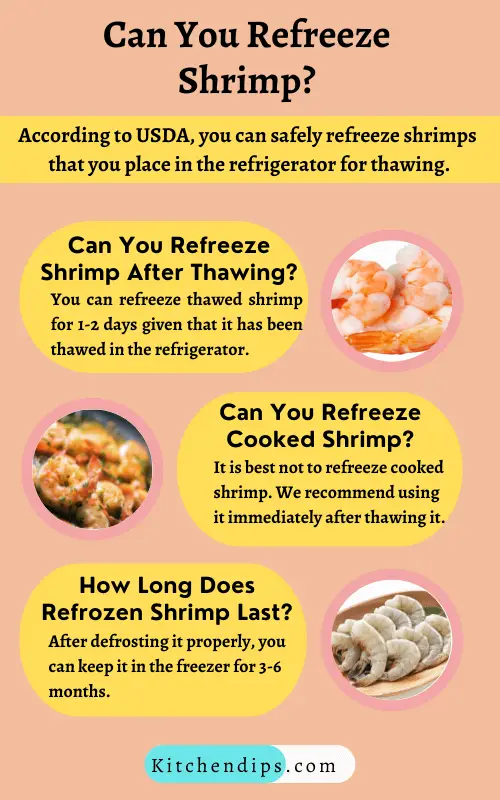Refreezing your shrimp, whether raw or cooked, needs some safety protocols. You might not want to throw away your favorite seafood while it is still edible. So, to utilize your defrosted shrimps again, you might need to inquire, can you refreeze shrimp?
You can safely refreeze shrimp if you thaw it in the refrigerator at less than 42°F. On the contrary, shrimp defrosted in the microwave or using cold water technique requires thorough cooking before freezing them again.
Though refreezing seafood, once they have already passed a long time in the freezer, might affect the taste to some degree. However, by following the correct safety measures, the juiciness of the shrimps can remain intact.
Table of Contents
Can You Refreeze Shrimp After Thawing?

The refreezing of shrimp directly depends upon the way you initially used to thaw them. It applies to both raw and cooked shrimp.
According to USDA, you can safely refreeze shrimps that you place in the refrigerator for thawing. They are not exposed much to an open atmosphere, resulting in lower chances of contamination. So, they can undergo refreezing without much hassle.
In the case of shrimps that you thaw in a microwave, do not survive another round of freezing.
This temperature makes them quite vulnerable to bacterial growth. As an outcome, freezing shrimps again becomes useless. So, It is better to cook them right away after thawing by this method.
Similarly, shrimps that you thaw with the cold water method are not suitable for refreezing. They can freeze well only if you cook them thoroughly. Freezing them again in raw form is useless.
Frozen Shrimp that you purchase from the store mostly thaw before reaching your destination. In this case, too, it is better to cook them first and not place them directly in the freezer.
Can You Refreeze Cooked Shrimp?
Taking health risks into consideration, we do not advise refreezing cooked shrimp that has undergone freezing once before. The best practice is to use it immediately when completely thawed; you can reheat frozen cooked shrimp if it is already a part of the prepared meal. If not, you can utilize it in several delicious recipes.
Nonetheless, if you don’t have plans to use the defrosted cooked shrimp, you can still try refreezing it, but make sure it was previously thawed in the fridge only and not by other means. Moreover, cooked shrimp must be refrozen as early as possible to reduce the chances of contamination.
How Can You Refreeze Shrimp?

Refreezing shrimp in the refrigerator is the best option to go with if you want to keep your shrimp fresh and in flavor. Other techniques might affect the texture and decrease their life span.
To properly refreeze your shrimps, the following steps might prove helpful.
- Cooked shrimp should be cooled down first before placing them in the fridge for refreezing. It will prevent them from getting freezer burns.
- For raw shrimps, keep their shell intact and avoid removing them. It will act as a protective covering for the meat.
- Store both the raw and cooked shrimp in a freezer-safe bag or an airtight container. It will stop other food flavors from getting absorbed by them.
- Now place the bag or container in a safe corner inside the freezer and let it freeze up to the required time.
- Ensure to label the bag with the date of refreezing as a reminder.
- It is also necessary to know that constant freezing and refreezing might affect the flavor and texture of the shrimp. Thus, it is best to use these once exposed to one round of double freezing.
How Long Does Refrozen Shrimp Last?
Raw shrimp frozen before can be kept in the freezer for 3-6 months if you follow the proper thawing method in the refrigerator. However, for the best results and experience, we suggest utilizing the shrimp as soon as possible.
In the case of thawed cooked shrimp, when stored properly, it will maintain its optimal quality for around 2-3 months. It will still be considered safe beyond the said period, but the quality will be compromised to a great degree.
Can You Refreeze Shrimp More Than Once?
It is recommended not to refreeze shrimp twice as this can affect the taste and texture. Moisture can leak out, making shrimp dry and less flavorful. However, if properly defrosted, they are safe to consume and pose no health risks.
It is better to buy small packages of seafood rather than larger ones in order to avoid refreezing repeatedly.
Are There Any Downsides To Refreezing Thawed Shrimp?
While refreezing can help avoid food wastage, there are a few notable disadvantages of freezing the thawed shrimp again.
Change in texture
Keeping any food in the freezer generally results in rupturing the cell walls of the product. The same is the case with shrimp and other seafood. As shrimp is known for its delectable texture, repeatedly refreezing it will spoil the overall quality.
Change in taste
The characteristic flavor of shrimp is affected by continuous freezing due to the formation of ice crystals. Every time you thaw this delicious seafood, it loses more and more of its former taste.
Health risks
Another drawback associated with refreezing shrimp is the high chance of bacterial growth. As a result, this can lead to many food-borne illnesses and other health complications. So, it is ideal to consume your shrimp once you thaw them.
Frequently Asked Questions
What is the best use of twice-thawed shrimps?
After undergoing twice-thawing, the shrimp's flesh loses its firmness and becomes mushy. As the overall taste is affected, the uses can become quite limited. You can serve them in soups, casseroles, sauces, and dips because the change in flavor will not be much evident.
How to know if the refrozen shrimps have spoiled?
Some visible indications help in detecting whether the refrozen shrimps are still edible or not. They include the appearance of brownish spots, a foul smell, and a color change. If any of these signs appear, discard the shrimps.
Can shrimps go bad in the freezer?
Shrimps can go bad in the freezer if you lose power or the temperature of the freezer drops for more than a few hours. Thus, this can turn the shrimps inedible and no longer safe to consume.
Recommended Readings:


